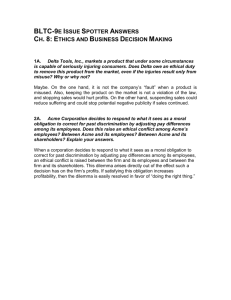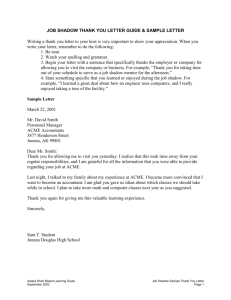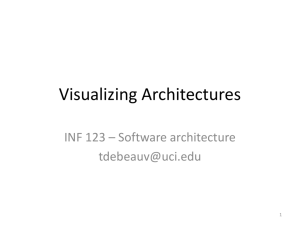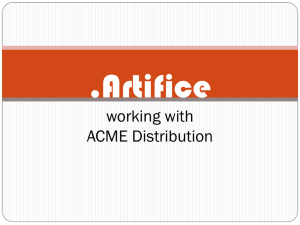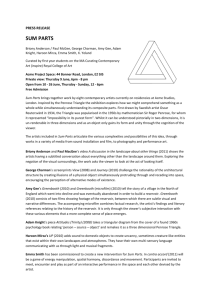xAcme: CMU Acme Extensions to xArch. Introduction
advertisement
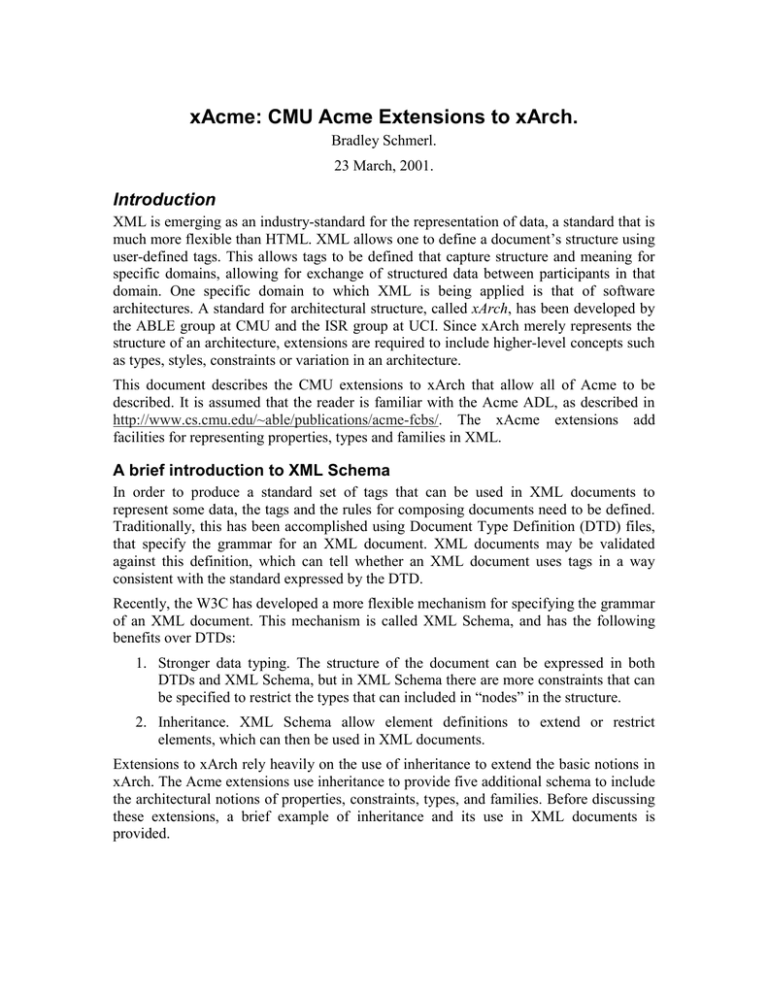
xAcme: CMU Acme Extensions to xArch.
Bradley Schmerl.
23 March, 2001.
Introduction
XML is emerging as an industry-standard for the representation of data, a standard that is
much more flexible than HTML. XML allows one to define a document’s structure using
user-defined tags. This allows tags to be defined that capture structure and meaning for
specific domains, allowing for exchange of structured data between participants in that
domain. One specific domain to which XML is being applied is that of software
architectures. A standard for architectural structure, called xArch, has been developed by
the ABLE group at CMU and the ISR group at UCI. Since xArch merely represents the
structure of an architecture, extensions are required to include higher-level concepts such
as types, styles, constraints or variation in an architecture.
This document describes the CMU extensions to xArch that allow all of Acme to be
described. It is assumed that the reader is familiar with the Acme ADL, as described in
http://www.cs.cmu.edu/~able/publications/acme-fcbs/. The xAcme extensions add
facilities for representing properties, types and families in XML.
A brief introduction to XML Schema
In order to produce a standard set of tags that can be used in XML documents to
represent some data, the tags and the rules for composing documents need to be defined.
Traditionally, this has been accomplished using Document Type Definition (DTD) files,
that specify the grammar for an XML document. XML documents may be validated
against this definition, which can tell whether an XML document uses tags in a way
consistent with the standard expressed by the DTD.
Recently, the W3C has developed a more flexible mechanism for specifying the grammar
of an XML document. This mechanism is called XML Schema, and has the following
benefits over DTDs:
1. Stronger data typing. The structure of the document can be expressed in both
DTDs and XML Schema, but in XML Schema there are more constraints that can
be specified to restrict the types that can included in “nodes” in the structure.
2. Inheritance. XML Schema allow element definitions to extend or restrict
elements, which can then be used in XML documents.
Extensions to xArch rely heavily on the use of inheritance to extend the basic notions in
xArch. The Acme extensions use inheritance to provide five additional schema to include
the architectural notions of properties, constraints, types, and families. Before discussing
these extensions, a brief example of inheritance and its use in XML documents is
provided.
1 <schema …>
2
<element name=”purchaseOrder” type=”PO”/>
3
4
5
6
7
8
9
10
<complexType name=”PO”>
<sequence>
<element name=”orderDate” type=”date”/>
<element name=”shippingDate” type=”date”/>
<element name=”billingAddress” type=”Address”/>
<element name=”shippingAddress” type=”Address”/>
</sequence>
</complexType>
11
12
13
14
15
16
17
18
<complexType name=”Address”>
<sequence>
<element name=”name” type=”string”/>
<element name=”street” type=”string”
minOccurs=”1” maxOccurs=”2”/>
<element name=”city” type=”string”/>
</sequence>
</complexType>
…
Figure 1. Schema Definition of an invoice.
Figure 1 provides a schema definition for purchase orders. The schema defines the tags
that can be used in an XML document and the order and contents of those tags. In the
schema defined in Figure 1, the first tag that can be used is <purchaseOrder>, which is
the top element in the schema (defined on Line 2). The structure of this element is
defined by the schema type PO, which is defined in lines 3-10. The type PO is in turn
defined as a sequence of elements whose tag names and types are defined in lines 5-8.
This definition specifies that a purchaseOrder must contain (in sequence) one each of
orderDate, shippingDate, billingAddress, and shippingAddress.
Lines 11-18 of Figure 1 define what an address looks like. Note that in this address, there
is no state or zip defined. The reason for this is that we wish to define purchaseOrders
that can be shipped or billed to international addresses, and the format of these is differs
from country to country. We can consider Address to be the base type of all addresses in
our purchaseOrders, and for this we assume that all addresses have in common a name,
one or two street elements and a city.
Figure 2 illustrates the extension of the base Address type defined in Figure 1 to two
international addresses: United States addresses and Australian addresses. The
USAddress type extends Address by adding two elements at the end of the sequence – a
state element and a zip element. The AusAddress type extends Address by adding two
different elements, a postcode and a state.1
These extensions can be used in place of an Address, by indicating their type (the
indication of their type could be omitted if there was no need to validate an XML
1
The state elements of USAddress and AusAddress are different types, but are not shown in the example.
These types could be enumerations containing the abbreviations of all 50 US states for USState, and all 8
Australian states and territories for AusState.
document). Figure 3 gives an example of an XML document that uses the schema defined
in Figure 1 and Figure 2. Line 4 of Figure 3 states that the billingAddress tag must
satisfy the type definition for USAddress; Line 11 states that the shippingAddress is an
AusAddress.
1
2
3
4
5
6
7
8
9
10
<complexType name=”USAddress”>
<complexContent>
<extension base=”Address”>
<sequence>
<element name=”state” type=”USState”/>
<element name=”zip” type=”positiveInteger”/>
</sequence>
</extension>
</complexContent>
</complexType>
11
12
13
14
15
16
17
18
19
20
<complexType name=”AusAddress”>
<complexContent>
<extension base=”Address”>
<sequence>
<element name=”postcode” type=”string”/>
<element name=”state” type=”AusState”/>
</sequence>
</extension>
</complexContent>
<complexType>
Figure 2. Extensions for US and Australian addresses.
1 <purchaseOrder>
2
<orderDate>2001-02-27</orderDate>
3
<shipDate>2001-03-01</shipDate>
4
<billingAddress xsi:type=”USAddress”>
5
<name>Bradley Schmerl</name>
6
<street>5000 Forbes Ave</street>
7
<city>Pittsburgh</city>
8
<state>PA</state>
9
<zip>15213</zip>
10
</billingAddress>
11
<shippingAddress xsi:type=”AusAddress”>
12
<name>Bradley Schmerl</name>
13
<street>48 Main North Road</street>
14
<city>Willaston</city>
15
<postcode>5118</postcode>
16
<state>SA</state>
17
</shippingAddress>
Figure 3. An example of inheritance in an XML document.
As stated previously, extension to xArch rely on the inheritance described in this section
to add structure to the basic elements defined in the xArch schema. More information
about XML Schema can be found at http://www.w3.org. A note of caution: many
resources on the web refer to the XML Schema candidate recommendation of April 2000.
However, the current XML Schema, and the one followed by xArch and its extensions, is
the candidate recommendation of October 2000.
A brief introduction to xArch
The xArch schema was defined jointly by CMU and UCI to provide a common definition
for the structural elements of an architectural instance. An architectural instance is an
instance of a structure which may occur at design time or runtime.
The types defined in xArch are:
ComponentInstance: an instance of a component. A component contains a
description and a set of interfaces, with a possible subArchitecture to represent
hierarchy.
ConnectorInstance: an instance of a connector, containing a description and a set
of interfaces. A connector may also contain a subArchitecture to represent
hierarchical decomposition.
LinkInstance: links define attachments between interfaces of components and
interfaces of connectors.
GroupInstance: a group is a collection of references to components and
connectors that form some logical grouping. For example, the group may
represent all components running on a particular machine or written by a
particular developer.
ArchInstance: an instance of an architecture, containing components, connectors,
links and groups.
More information on xArch can be found at http://www.isr.uci.edu/projects/xarchuci/.
There are a number of differences between instances as described by xArch and instances
as described by Acme. These differences are:
♦
roles and ports are not distinguished in xArch – both are refered to as
InterfaceInstances;
♦
there are no properties attached to any of the elements. It is intended that
the description element be used as non-interpreted property elements;
♦
the hierarchical decomposition of connectors and components is restricted
to one choice; in Acme, connectors and components may have multiple
representations;
♦
interfaces (ports and roles) in Acme are allowed to have representations;
in xArch, this is not possible; and
♦
xArch provides a grouping facility that Acme does not support.2
It is necessary, therefore, to extend xArch to support these additional Acme features, in
addition to support for higher-level Acme concepts such as families and types.
2
Prior to the definition of xArch, there had been some discussion about adding a grouping mechanism to
Acme. Watch for a proposal to extend Acme to support groups.
CMU Acme Extensions
The Acme extensions defined by CMU extend the basic xArch structural core to include
properties, multiple representations, types, and families. These extensions are expressed
in five separate schema definitions that use schema inheritance as the extension
mechanism.
The goal of the Acme extensions for xArch are to allow tools that describe architectures
using Acme to be able to interchange architectural descriptions with tools that understand
xArch. Standard XML parsers and tools can be used to build and save the XML
representations, saving developers from having to rewrite these tools for particular
architecture languages. The ultimate aim of xArch is to be able to use extensions created
by other institutions; however, the current inheritance model of XML schema only allow
this in cases where the two schema are non-interfering, i.e., both schema do not extend
the same type.
The five Acme extensions to xArch are:
properties: adds simple properties to xArch instances. At this level, properties
have no detailed structure; they simply consist of a name, a value and a type, each
represented by uninterpreted strings. In addition, support for multiple
subarchitectures is included in this extension.
acmeProperties: extends properties by adding structure to property types and
values consistent with Acme property values and types. Structures for sets,
sequences, records, and enumerated types are included.
families: adds to properties support for types of components, connectors,
interfaces and properties, as well as the collection of all of these types into
families. Instances defined in the properties schema are extended to refer to
families as supertypes; in addition to this, instances may refer to a particular
family used to define the default structure of the instance.
constraints: extends families to add support for general constraints. At this level,
constraints merely have a type and a description, both of which are uninterpreted
strings.
acmeConstraints: extends constraints to add support for Armani constraints to
instances.
Figure 4 illustrates the hierarchical inheritance structure of the xArch Acme extensions.
As mentioned above, xArch is the base schema, representing architectural structure. The
arrow in the diagram represents an inheritance and use relation. Thus, tag types defined in
the properties extension extend tag types in the xArch schema, and may also
compositionally use types defined in xArch. The dashed line represents compositional
use only. Thus, acmeConstraints uses acmeProperties but extends (or inherits from) types in
constraints.
xArch
properties
acmeProperties
families
constraints
acmeConstraints
Figure 4. Organization of the xArch Acme extensions
Descriptions
This section describes the five Acme extensions, providing definitions of the added
elements and types, and how they inherit from other schema.
Extension 1: properties
The properties extension allows design elements to be annotated with properties consisting
of name, type and value. In each of these cases, the values are uninterpreted string. It is
left to tools to interpret the values. The acmeProperties extension gives the XML Schema
definition for the abstract syntax of Acme-style properties with structured values and
types.
The properties extension defines the following new types:
PropertyValue: a type that contains no substructure, but has a string attribute
(description) that contains the string representation of the value.
PropertyType: a type that contains no substructure, but has a string attribute
(description) that contains the string representation of a type.
Property: a type that has a name attribute (defining the name of the property) and
a sequence containing one each of PropertyValue and PropertyType.
In addition, the properties extension extends the following xArch types:
ComponentInstance,
ConnectorInstance,
InterfaceInstance,
Group,
ArchInstance: Each of these is extended to include zero or more <property>
tags, each of type Property.
ComponentInstance, ConnectorInstance: The arity of the subArchitecture
component is extended to include multiple subArchitectures, which model Acme
representations.
Example of use
Figure 5 gives two examples of using the properties extension and the associated Acme
equivalents. In the XML example, the convention <extension:tag> is used to denote
the extension in which a tag is defined. Figure 5(a) defines an Acme property as a
sequence of integers. The corresponding XML denotation of this Acme property using
the properties extension is given in Figure 5(b). Note that the detailed Acme sequence
structure is captured within the description attribute of the value and type tags.
Figure 5(c) shows an Acme component definition containing one port and one integer
property. The XML in Figure 5(d) shows the use of inheritance to capture this more
complex component in xArch.3 The XML instance of componentInstance (whose id is
c2) is actually an XML instance of the schema type properties:componentInstance. In
this way, the properties can be added to a component instance.
Extension 2: acmeProperties
The acmeProperties extension adds support for structured property values and types,
following the Acme language definition of properties. The PropertyValue and
PropertyType tags, defined as strings in the properties extension, are extended to include
this structure.
The PropertyType tag type is extended to be a choice of the following types:
PropertyPrimitiveType: This element type is an empty tag that contains a type
attribute that can have values restricted to those of primitive Acme types, i.e.,
integer, float, string, double, long, any, uri, or char.
PropertySetType: This element type is used to represent a type that is an Acme
set. This type consists of one element, which refers to another type that represents
the type of the members of the set.
PropertySequenceType: This element type is used to represent a type that is an
Acme sequence. This type consists of one element, which refers to another type
that represents the type of the members of the sequence.
PropertyEnumType: This element type is used to represent an Acme enumerated
type. The type is defined by listing the potential values of the type as strings.
PropertyRecordType: This element type defines an Acme record. It is composed
of one or more PropertyFieldTypes, also defined in this extension.
XMLLink: This element type (defined in instances) is used to refer to an already
defined type.
3
Note that this XML would be embedded in a bigger XML document, as is not valid in itself.
property events : sequence <int> =
<12, 1, 14, 5>;
(a)
<properties:property name=”events”>
<properties:value
description=”<12, 1, 14, 5>”/>
<properties:type
description=”sequence <int>”/>
<properties:property>
(b)
component c2 = {
port in;
property throughput : int = 2;
}
(c)
<xArch:componentInstance id = “c2”
xsi:type=”properties:ComponentInstance”>
<xArch:description/>
<xArch:interfaceInstance id=”in”>
<xArch:description/>
</xArch:interfaceInstance>
<properties:property name=”throughput”>
<properties:value description=”2”/>
<properties:type description=”int”/>
</properties:property>
</xArch:componentInstance>
(d)
Figure 5. Examples of using elements from the properties extension.
The PropertyValue tag type is extended to include a choice of the following values,
representing literals of the Acme property types.
PropertyPrimitiveValue: XML Schema datatypes are used to define the contents
of the corresponding primitive values.
PropertySetValue: This is a list of PropertyValues.
PropertySequenceValue: This is a list of PropertyValues with an associated
sequence number.
PropertyRecordValue: This is a list of PropertyFieldValues.
Example of use
Figure 6 shows the definition of an Acme component using the acmeProperties extension.
This component is the one defined in Figure 5(c). acmeProperties is used in the definition
of the value and the type. The value is defined on lines 8-16 of Figure 6; the type is
defined on lines 17-21. The tag type of the value of the property is the PropertyValue
from acmeProperties. It contains a propertyPrimitiveValue which contains an
intValue. The type of the property is represented by a PropertyType defined in the
acmeProperties extension.
1
2
3
4
5
6
7
8
9
10
11
12
13
14
15
16
<xArch:componentInstance id = “c2”
xsi:type=”properties:ComponentInstance”>
<xArch:description/>
<xArch:interfaceInstance id=”in”>
<xArch:description/>
</xArch:interfaceInstance>
<properties:property name=”throughput”>
<properties:value
xsi:type = “acmeProperties:PropertyValue”
description=”2”>
<acmeProperties:propertyPrimitiveValue>
<acmeProperties:intValue>
2
</acmeProperties:intValue>
</acmeProperties:propertyPrimitiveValue>
</properties:value>
17
<properties:type
18
xsi:type=”acmeProperties:PropertyType”
19
description=”int”>
20
<acmeProperties:propertyPrimitiveType type=”int”/>
21
</properties:type>
22
</properties:property>
23 </xArch:componentInstance>
Figure 6. Example of using the elements from the acmeProperties extension.
Extension 3: families
The families extension extends tag types in the properties extension to add support for
Acme types and families. The following new tag types are introduced:
ComponentType, ConnectorType, InterfaceType: Each of these types extends the
respective instance definition in the properties extension. For example, the
ComponentInstance type defined in properties defines the default structure for the
ComponentType in the families extension. In addition, each of these tag types has zero or
more links to supertypes.
Family: A family is a collection of element types and an optional default
structure. The family may also refer to zero or more super families.
TypedComponentInstance, TypedConnectorInstance,
TypedInterfaceInstance: These instances extend the element instances defined
in the properties extension to refer to zero or more types. Additionally, the
instances can refer to a particular type to instantiate their default structure, which
corresponds to the “new” phrase in Acme.
TypedDesign: A typed design is a collection of family definitions and system
definitions.
family pipeFilter = {
port type Readport;
port type WritePort;
component type filter = {
port stdin : ReadPort;
port stdout : WritePort;
}
}
(a)
1
2
3
4
5
6
7
8
9
10
11
12
13
14
15
16
17
18
<families:typedDesign>
<families:family id=”pipeFilter”>
<families:interfaceType id=”ReadPort”/>
<families:interfaceType id=”WritePort”/>
<families:componentType id=”Filter”>
<families:structure>
<xArch:interfaceInstance
id=”stdin”
xsi:type=”families:typedInterfaceInstance”>
<families:type href=”#ReadPort”/>
</xArch:interfaceInstance>
<xArch:interfaceInstance
id=”stdout”
xsi:type=”families:typedInterfaceInstance”>
<families:type href=”#WritePort”/>
</xArch:interfaceInstance>
</families:structure>
</families:componentType>
19
</families:family>
20 </families:typedDesign>
(b)
Figure 7. The definition of an Acme family and the associated definition using the families extension.
Example of use
Figure 7 illustrates the definition of an Acme family, containing two port types and one
component type, in both Acme and xArch:Acme. We will assume that the xArch
definition is contained in a file called pipeFilter.xml.
Figure 8 shows the definition of a system that uses the family defined in Figure 7. Figure
8(a) shows an Acme definition, while Figure 8(b) shows the corresponding XML
encoding. Note the use of references to the types defined in pipeFilter.xml on lines 9, 10,
18, and 19 of Figure 8(b). These refer to the definitions in Figure 7(b).
system simple-demo : pipeFilter = {
component Capitalize : Filter = new Filter extended with {
port stdin : ReadPort = new ReadPort;
port stdout : WritePort = new WritePort;
}
}
(a)
1 <xArch:archInstance id="simple-demo"
2
xsi:type="families:ArchInstance">
3
<xArch:component id="Capitalize"
4
xsi:type="families:ComponentInstance">
5
<xArch:description/>
6
<xArch:interfaceInstance id="stdin"
7
xsi:type="families:InterfaceInstance">
8
<xArch:description/>
9
<families:type href="pipeFilter.xml#ReadPort"/>
10
<families:instanceOf href="pipeFilter.xml#ReadPort"/>
11
</xArch:interfaceInstance>
12
<xArch:interfaceInstance id="stdout"
13
xsi:type="families:InterfaceInstance">
14
<xArch:description/>
15
<families:type href="pipeFilter.xml#WritePort"/>
16
<families:instanceOf href="pipeFilter.xml#WritePort"/>
17
</xArch:interfaceInstance>
18
<families:type href="pipeFilter.xml#Filter"/>
19
<families:instanceOf href="pipeFilter.xml#Filter"/>
20 </xArch:component>
21 </xArch:archInstance>
(b)
Figure 8. An example of a component instance using the families extension.
Extension 4: constraints
The constraints extension adds unstructured constraints to the elements defined in the
families extension. In this extension, a constraint is composed of two attributes: a type
attribute and a description attribute. The description is the definition of the constraint in
plain text. The type, also plain text, is meant to indicate the use of the constraint. In the
Acme extensions, this is restricted to heuristic and invariant, but in other extensions could
indicate whether a constraint is dynamically evaluated, or even the constraint engine used
for evaluation. The constraints extension defines the following new types, which add the
general constraint’s respective definitions in the families extension:
♦
ConstrainedComponentInstance,
♦
ConstrainedConnectorInstance,
♦
ConstrainedInterfaceInstance, and
♦
ConstrainedArchInstance.
Example of use
Figure 9 shows the encoding of an Acme constraint using the constraints extension. Note
that in this figure, the acmeProperties extension is not used to encode the properties – only
the properties extension is. The constraint is captured in lines 11-13 as two string
attributes.
component c1 = {
property latency : int;
property maxLatency : int = 100;
invariant latency < maxLatency;
}
(a)
1
2
3
<xArch:component
id=”c1”
xsi:type=”constraints:ConstrainedComponentInstance”>
4
5
6
<properties:property id=”latency”>
<properties:type description=”int”/>
</properties:property>
7
8
9
10
<properties:property id=”maxLatency”>
<properties:type description=”int”/>
<properties:value description=”100”/>
</properties:property>
11
12
13
14
<constraints:constraint
type=”invariant”
description=”latency < maxLatency;”/>
</xArch:component>
(b)
Figure 9. An example of using the constraints extension to model an Acme component with constraints.
Extension 5: acmeConstraints
The acmeConstraints extension extends the constraints extension to support structure
corresponding to Acme constraints.4 This extension essentially defines an abstract syntax
tree for the constraint expression. In addition, it adds facilities for defining design
analyses – functions that can be defined and used in constraints. Because this extension
essentially follows the grammar of the Armani predicate language, it is quite large, and so
all of the new types defined in this extension are not enumerated. At the top level, the
new tag types introduced at this level are:
DesignAnalysisDeclaration: This tag type begins the declaration of a design
analysis function, which has a name, some parameters, a return type and a
definition.
DesignRule: A DesignRule extends the Constraint tag type from Constraints. It
makes two changes: the first is to add a tag that contains the XML encoding of the
constraint structure, a choice of a quantified expression or a boolean expression;
the second is that it restricts the type attribute of the tag type to contain one of two
possible values: heuristic or invariant.
4
In this document we equate Acme constraints with Armani constraints.
latency < maxLatency and !overloaded
(a)
BooleanExpression
PrimitiveExpression
PrimitiveExpression (<)
PrimitiveExpression (and)
latency
maxLatency
UnaryExpression (!)
PrimitiveExpression
overloaded
(b)
BooleanExpression (and)
OrExpression
OrExpression
ImpliesExpression
ImpliesExpression
IffExpression
IffExpression
EqualityExpression
EqualityExpression
RelationalExpression (<)
RelationalExpression
AdditiveExpression
AdditiveExpression
AdditiveExpression
MultiplicativeExpression
MultiplicativeExpression
MultiplicativeExpression
UnaryExpression
UnaryExpression
UnaryExpression (!)
PrimitiveExpression
PrimitiveExpression
UnaryExpression
latency
maxLatency
PrimitiveExpression
overloaded
(c)
Figure 10. Example of expression flattening.
A complete encoding of the syntax of a constraint would be too unwieldy in practice
because the grammar definition has a deep nesting structure that encodes operator
precedence. To avoid the deep structure in the XML, a Boolean expression is a sequence
of primitive expressions, each of which has an attribute that defines the relation (or
connector) between the primitive expression containing the connector and the previous
component c1 = {
port stdin {property latency : int = 50;};
port stdout … {property latency : int = 75;};
invariant forall p : port in self.ports |
p.latency < 100;
(a)
1 <xArch:componentInstance id=”c1”
2
xsi:type=”constraints:ConstrainedComponentInstance”>
3
<xArch:interfaceInstance id=”stdin”
4
xsi:type=”properties:InterfaceInstance”>
5
<properties:property id=”stdin.latency”>
6
<properties:value desription=”50”/>
7
<properties:type description=”int”/>
8
</properties:property>
9
</xArch:interfaceInstance>
10
<xArch:interfaceInstance id=”stdout”
11
xsi:type=”properties:InterfaceInstance”>
12
<properties:property id=”stdout.latency”>
13
<properties:value desription=”75”/>
14
<properties:type description=”int”/>
15
</properties:property>
16
</xArch:interfaceInstance>
17
<constraints:constraint xsi:type=”acmeConstraints:DesignRule”
18
type=”invariant”>
19
<acmeConstraints:expression>
20
<acmeConstraints:quantifiedExpression>
21
<acmeConstraints:quantifier id=”p”>
22
<acmeConstraints:predefinedType>
23
Port
24
</acmeConstraints:predefinedType>
25
</acmeConstraints:quantifier>
26
<acmeConstraints:setExpression set=”interfaces”>
27
<acmeConstraints:element href=”#c1”/>
28
</acmeConstraints:setExpression>
29
<acmeConstraints:expression>
30
<acmeConstraints:booleanExpression>
31
<acmeConstraints:primitiveExpression>
32
<acmeConstraints:quantifierAccess access=”latency”>
33
<acmeConstraints:quantifier href=”#p”/>
34
</acmeConstraints:quantifierAccess>
35
</acmeConstraints:primitiveExpression>
36
<acmeConstraints:primitiveExpression connector=”lt”>
37
<acmeConstraints:literalValue>
38
<acmeConstraints:intValue>100</intValue>
39
</acmeConstraints:literalValue>
40
</acmeConstraints:primitiveExpression>
41
</acmeConstraints:booleanExpression>
42
</acmeConstraints:expression>
43
</acmeConstraints:quantifiedExpression>
44
</acmeConstraints:expression>
45
</constraints:constraint>
46 </xArch:component>
(b)
Figure 11. An example of using acmeConstraints
primitive expression. Thus, the expression tree is flattened in the XML definition, and it
is left to tools to handle the operator precedence.
Figure 10 provides an example of how the expression flattening works. The expression in
Figure 10(a) is flattened in the XML to look like the expression tree in Figure 10(b),
rather than the deep expression tree represented in Figure 10(c), and corresponding to the
Acme syntax.
Example of use
Figure 11 gives an example of defining an Acme component containing constraints using
the acmeConstraints extension. Note that the extension point for acmeConstraints is at the
level of constraints, rather than extending the component. This means that other
extensions can be written that extend components but need not use the acmeConstraints.
Comparison to ADML
ADML is an XML encoding of Acme that was developed by MCC and adopted by the
Open Group as a standard for architectural representation. There are a number of
differences between ADML and xAcme:
♦
ADML encodes Acme 1.0, whereas xAcme embodies the extensions to the
Acme included in Acme 3.0. Primarily, these include facilities for
encoding architectural design constraints and design analyses.
♦
ADML is defined using a DTD, whereas xAcme is defined using XML
Schema. Using XML Schema provides for a layered approach to the
schema which affords easier extension in the future.
♦
ADML uses unparsed strings to represent references to other Acme
entities, whereas xAcme uses Xlinks. For example, if a component needs
to refer to a type, the name is encoded inside an additional XML tag in
ADML, but is referred to using Xlinks in xAcme.
Despite these differences, we believe that xAcme is an evolution of ADML, and where
feasible, we have attempted to use the same tag names in xAcme as appear in ADML.
